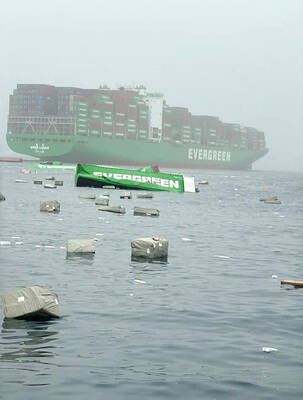To help the nation respond faster to undersea earthquakes and tsunamis, the Central Weather Bureau said it would soon deploy more advanced monitoring equipment.
Kuo Kai-wen (郭鎧紋), director of the bureau’s seismology center, said the Marine Cable Hosted Observatory (MACHO) was designed to improve the bureau’s ability to detect and monitor earthquakes and tsunamis off the east coast.
The system will be implemented in two stages. First, a 45km cable will be laid from a land station in Toucheng (頭城), Yilan County, out to sea next year. The project will be launched after the birthday of the sea goddess Mazu (媽祖), he said.
“A magnitude 7.1 earthquake between Hsinchu and Taichung hit at 6am on April 21, 1935. About 3,500 people died and 50,000 houses collapsed or semi-collapsed,” Kuo said. “It was close to Mazu’s birthday and some people survived because they were out worshipping the goddess.”
The second stage of the project will double the cable’s length, Kuo said.
The seismometer, or pressure gauge, in the MACHO system will help detect earthquakes and tsunamis, the information being transmitted via the cable to the bureau. The bureau will then analyze the information and produce reports for relief agencies, the media and the public.
The bureau estimates that the project, scheduled for completion by 2014, will cost about NT$800 million (US$25 million). Once installation is finished, Kuo said the nation could gain an extra 10 or 20 seconds to respond to strong earthquakes centered off the northeast coast. It could also provide an extra 10 to 20 minutes to prepare for a tsunami.
Aside from the MACHO system, the bureau also plans to expand the installation of borehole seismometers on land, Kuo said, adding that six more could be built this year. By last year, the bureau had completed nine such seismometers, Kuo said.
“The seismometers have lowered interference from the ground and reduced the risk of incorrect analysis,” he said.
The bureau has reduced the time from when an earthquake occurs to when the computer system reports the information from 102 seconds in 1999 to 30 seconds last year.
Meanwhile, the bureau said intermittent showers were expected throughout Taiwan starting yesterday as Typhoon Malou moves northward in the Sea of Japan.
The typhoon was expected to reach a location 530km north-northwest of Okinawa by 2am today and to change direction, moving north, forecasters said.
Malou is not expected to hit Taiwan directly, but the accompanying cloud system will bring intermittent rain across the country in the coming week, the bureau said.

“China is preparing to invade Taiwan,” Deputy Minister of Foreign Affairs Francois Wu (吳志中) said in an exclusive interview with British media channel Sky News for a special report titled, “Is Taiwan ready for a Chinese invasion?” the Ministry of Foreign Affairs said today in a statement. The 25-minute-long special report by Helen Ann-Smith released yesterday saw Sky News travel to Penghu, Taoyuan and Taipei to discuss the possibility of a Chinese invasion and how Taiwan is preparing for an attack. The film observed emergency response drills, interviewed baseball fans at the Taipei Dome on their views of US President

ECONOMIC BENEFITS: The imports from Belize would replace those from Honduras, whose shrimp exports have dropped 67 percent since cutting ties in 2023 Maintaining ties with Taiwan has economic benefits, Ministry of Foreign Affairs officials said yesterday, citing the approval of frozen whiteleg shrimp imports from Belize by the Food and Drug Administration (FDA) as an example. The FDA on Wednesday approved the tariff-free imports from Belize after the whiteleg shrimp passed the Systematic Inspection of Imported Food, which would continue to boost mutual trade, the ministry said. Taiwan’s annual consumption of whiteleg shrimps stands at 30,000 tonnes, far exceeding domestic production, the ministry said. Taiwan used to fill the gap by importing shrimps from Honduras, but purchases slumped after Tegucigalpa severed diplomatic ties with Taiwan

The Executive Yuan yesterday approved a southwestern extension of the Sanying MRT Line from New Taipei to Bade District (八德) in Taoyuan, with a goal of starting construction by late 2026. The 4.03-kilometer extension, featuring three new stations, will run from the current terminus at Yingtao Fude Station (LB12) in New Taipei City to Dannan Station (LB14), where it will connect with Taoyuan’s Green Line, New Taipei City Metro Corp said in a statement. This extension will follow the completion of core Sanying Line, a 14.29-kilometer medium-capacity system linking Tucheng (土城), Sansia (三峽)

CARGO LOSS: About 50 containers at the stern of the ‘Ever Lunar’ cargo ship went overboard, prompting the temporary closure of the port and disrupting operations Evergreen Marine Corp, Taiwan’s largest container shipper, yesterday said that all crew members aboard the Ever Lunar (長月) were safe after dozens of containers fell overboard off the coast of Peru the previous day. The incident occurred at 9:40am on Friday as the Ever Lunar was anchored and waiting to enter the Port of Callao when it suddenly experienced severe rolling, Evergreen said in a statement. The rolling, which caused the containers to fall, might have been caused by factors including a tsunami triggered by an earthquake in Russia, poor winter sea conditions in South America or a sudden influx of waves,